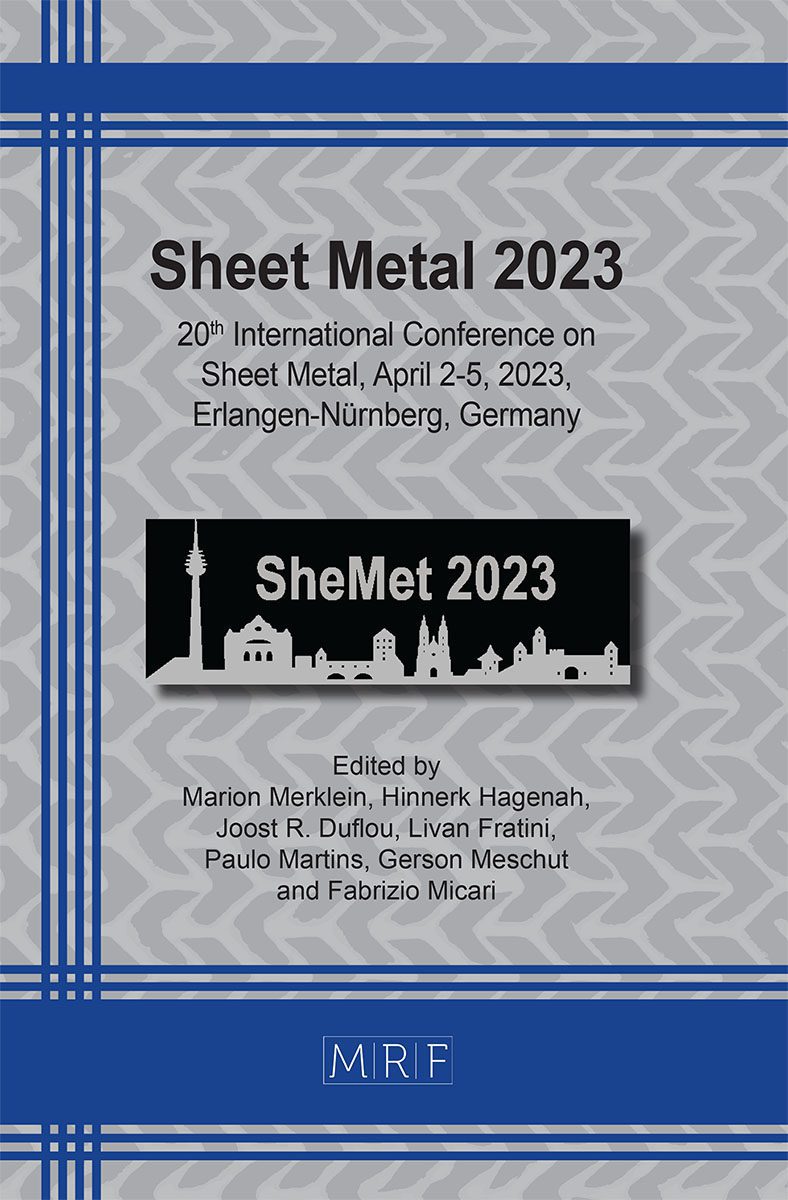Preliminary study of the mechanical characteristics implementation of friction stir welded AA2024 joints by adding pure copper
Sara Bocchi, Gianluca D’Urso, Claudio Giardini
download PDFAbstract. In the present paper, the mechanical properties of a AA2024 welded by Friction Stir Welding (FSW) were examined, both homogeneously and using a commercial pure copper sheet positioned between the edges to be welded in two configurations, T and C. The temperature trends reached during the FSW process were extrapolated through the development of a simulative model, to select the best combination of parameters to use in the experimental phase of the campaign. After that, the FSWed homogeneous and heterogeneous joints were executed and analysed. From the mechanical point of view, Rockwell B hardness tests and tensile tests were performed. It was possible to evidence a good relationship between the hardness distribution and the presence of the copper, especially at the nugget. On the contrary, the tensile tests executed orthogonally to the welding direction, showed a reduction of the tensile strength and of the real elongation percentage in the aluminium-copper heterogeneous FSWed joints.
Keywords
Friction Stir Welding, Aluminium, Solid State Diffusivity
Published online 3/17/2023, 8 pages
Copyright © 2023 by the author(s)
Published under license by Materials Research Forum LLC., Millersville PA, USA
Citation: Sara Bocchi, Gianluca D’Urso, Claudio Giardini, Preliminary study of the mechanical characteristics implementation of friction stir welded AA2024 joints by adding pure copper, Materials Research Proceedings, Vol. 25, pp 213-220, 2023
DOI: https://doi.org/10.21741/9781644902417-27
The article was published as article 27 of the book Sheet Metal 2023
![]() Content from this work may be used under the terms of the Creative Commons Attribution 3.0 licence. Any further distribution of this work must maintain attribution to the author(s) and the title of the work, journal citation and DOI.
Content from this work may be used under the terms of the Creative Commons Attribution 3.0 licence. Any further distribution of this work must maintain attribution to the author(s) and the title of the work, journal citation and DOI.
References
[1] W. M. Thomas, E. D. Nicholas, J. C. Needham, M. G. Murch, P. Templesmith, and C. J. Dawes, “GB Patent application no. 9125978.8,” 1991.
[2] M. Tabasi, M. Farahani, M. K. B. Givi, M. Farzami, and A. Moharami, “Dissimilar friction stir welding of 7075 aluminum alloy to AZ31 magnesium alloy using SiC nanoparticles,” Int. J. Adv. Manuf. Technol., vol. 86, no. 1–4, pp. 705–715, Sep. 2016. https://doi.org/10.1007/s00170-015-8211-y
[3] H. Sehitoglu, T. Foglesong, and H. J. Maier, “Precipitate effects on the mechanical behavior of aluminum copper alloys: Part I. Experiments,” Metall. Mater. Trans. A, vol. 36, no. 3, pp. 749–761, Mar. 2005. https://doi.org/10.1007/s11661-005-0190-4
[4] C. Sigli, F. De Geuser, A. Deschamps, J. Lépinoux, and M. Perez, “Recent advances in the metallurgy of aluminum alloys. Part II: Age hardening,” Comptes Rendus Physique, vol. 19, no. 8. No longer published by Elsevier, pp. 688–709, 01-Dec-2018. https://doi.org/10.1016/j.crhy.2018.10.012
[5] M. Jariyaboon et al., “The effect of welding parameters on the corrosion behaviour of friction stir welded AA2024–T351,” Corros. Sci., vol. 49, no. 2, pp. 877–909, Feb. 2007. https://doi.org/10.1016/j.corsci.2006.05.038
[6] E. B. Hannech, N. Lamoudi, N. Benslim, and B. Makhloufi, “Intermetallic formation in the aluminum-copper system,” Surf. Rev. Lett., vol. 10, no. 4, pp. 677–683, Apr. 2003. https://doi.org/10.1142/S0218625X03005396
[7] W. Bedjaoui, Z. Boumerzoug, and F. Delaunois, “Solid-State Diffusion Welding of Commercial Aluminum Alloy with Pure Copper,” Int. J. Automot. Mech. Eng., vol. 19, no. 2, pp. 9734–9746, Jun. 2022. https://doi.org/10.15282/ijame.19.2.2022.09.0751
[8] M. Quarto, S. Bocchi, G. D’, N. A. Urso, and C. Giardini, “Hybrid finite elements method-artificial neural network approach for hardness prediction of AA6082 friction stir welded joints,” Int. J. Mechatronics Manuf. Syst., vol. 15, no. 2/3, p. 149, 2022. https://doi.org/10.1504/IJMMS.2022.124919
[9] T. Rajkumar, K. Raja, K. Lingadurai, S. D. Vetrivel, and A. Godwin Antony, “Interfacial microstructure analysis of AA2024 welded joints by friction stir welding,” J. New Mater. Electrochem. Syst., vol. 23, no. 2, pp. 123–132, Apr. 2020. https://doi.org/10.14447/jnmes.v23i2.a09
[10] N. S. Abtan, A. H. Jassim, and M. S. Marmoos, “Study on the effects of rotational and transverse speed on temperature distribution through friction stir welding of AA2024-T3 aluminium alloy,” J. Adv. Res. Fluid Mech. Therm. Sci., vol. 53, no. 2, pp. 234–248, 2019.
[11] M. Cabrini et al., “Stress corrosion cracking of friction stir-welded AA-2024 T3 alloy,” Materials (Basel)., vol. 13, no. 11, Jun. 2020. https://doi.org/10.3390/ma13112610
[12] A. W. El-Morsy, M. Ghanem, and H. Bahaitham, “Effect of Friction Stir Welding Parameters on the Microstructure and Mechanical Properties of AA2024-T4 Aluminum Alloy,” Eng. Technol. Appl. Sci. Res., vol. 8, no. 1, pp. 2493–2498, Feb. 2018. https://doi.org/10.48084/etasr.1704
[13] S. Bocchi, M. Cabrini, G. D’Urso, C. Giardini, S. Lorenzi, and T. Pastore, “Stress enhanced intergranular corrosion of friction stir welded AA2024-T3,” Eng. Fail. Anal., vol. 111, Apr. 2020. https://doi.org/10.1016/j.engfailanal.2020.104483
[14] R. Khajeh et al., “Microstructure, mechanical and electrical properties of dissimilar friction stir welded 2024 aluminum alloy and copper joints,” J. Mater. Res. Technol., vol. 14, pp. 1945–1957, Sep. 2021. https://doi.org/10.1016/j.jmrt.2021.07.058































